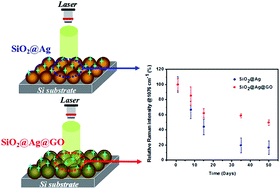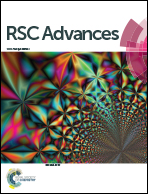Graphene oxide wrapped individual silver nanocomposites with improved stability for surface-enhanced Raman scattering†
Abstract
As one of the best materials for surface-enhanced Raman scattering (SERS), Ag suffers from its tendency to oxidation, posing serious limitations for its use as a reliable long-term SERS substrate. Graphene oxide (GO) is considered to be a promising SERS-active platform due to the observed chemical enhancement originating from the interaction between probe molecules and oxygen containing functional groups on its surface. Herein, we present the synthesis of core–shell GO wrapped individual Ag nanocomposites (NCs) by electrostatic assembly of GO on SiO2@Ag nanostructures. The SERS enhancement factor (EF) of probe molecules on SiO2@Ag@GO is 1.8 times that on SiO2@Ag, due to the chemical enhancement brought upon by GO. Moreover, the GO surrounding the SiO2@Ag nanoparticles (NPs) shields Ag from oxidation, making them remain stable and display highly retained SERS activities even after long-term storage, while the bare SiO2@Ag NPs would have lost ∼80% of the original activity after the same treatment. As the NCs have displayed enhanced and stable SERS activities, colloidal encapsulation by GO has been proven to be an efficient way to prepare a SERS substrate with long-term stability for practical applications.

- This article is part of the themed collection: Surface enhanced Raman Spectroscopy: Editors collection for RSC Advances

 Please wait while we load your content...
Please wait while we load your content...